Trending
Opinion: How will Project 2025 impact game developers?
The Heritage Foundation's manifesto for the possible next administration could do great harm to many, including large portions of the game development community.
In the arcades, pencil-thin arms have manipulated the torsos of 500 pound Sumo wrestlers for over 10 years. How did this game phenomenon happen? And why? Developer Simon Carless rolls up his sleeves, flexes his triceps, and dives into the story behind the evolution of Fighting Game genre.

In the beginning, there was "Pong". And God looked down upon it, and saw that it was good. But soon enough, people realized that bats and balls just weren't fun enough - they really wanted to be kicking some butt.
Jittering lines of beeping space aliens to blast amused people - but soon they wanted more. They wanted something they could identify with, something closer to home - they wanted some mortal combat. And, back in 1984, Data East gave them that with "Karate Champ", allegedly the first one-on-one beat-em-up. Almost fifteen years later, we have "Tekken 3", "Capcom vs. Marvel", "Star Wars:Masters of Teras Kasi", and a host of other beat-em-ups which, quite frankly, still kick ass. So how has this most enduring of genres evolved? And why?
Origins
The reasons for the evolution of a genre are always oblique. The lust for violence implied in the introduction probably isn't the reason for the beat-em-up coming about, to be honest.
In fact, if you look at popular culture as inspiration for genres, it's easy to see why the beat-em-up was a natural step. "Space Invaders" and its ilk were naturally influenced by movies such as "Close Encounters of the Third Kind" and the reams of UFO literature. Science fiction was the staple on which to base the majority of titles.
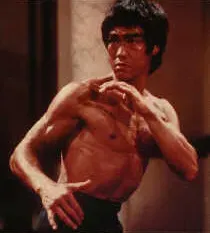
Bruce Lee, Video Game Inspiration
But for the young Japanese and American programmers, who still needed strong and simplistic themes to drive their graphically simple games, there began to be other options. Bond movies spawned "Spy Hunter". The fantasy genre influenced titles such as "Joust". And the world of Bruce Lee and martial arts allowed the beat-em-up to evolve. It was easy to see why it appealed - the heroism of combat, the stylishness of the martial arts hero. In Japan, martial arts were much more ingrained into culture. But, even elsewhere in the world, Bruce Lee had made kung-fu a phenomenon. Jackie Chan was the epitome of the chopsocky stereotype in his brief guest appearance in "Cannonball Run". The beat-em-up, if you'd pardon the pun, hit all the right buttons. It was a worldwide success. But, only to an extent.
So the one-on-one beat-em-up evolved in the early 1980s. Yet it wasn't until the early 1990s that the genre really took off. Why was that?
Well, there was definitely a problem.. lack of character. Which is where we can bring in the other half of the beat-em-up genre, the one we've been side-stepping up to now - the sideway-scrolling beat-em-up. When making beat-em-ups, using quite primitive sound and graphics, a range of complicated moves was out of the question. And with such simple visuals, imbuing graphics with any character or individuality was also very tricky. So it's noticable that, throughout the eighties, the enduringly successful arcade games were much more geared to defeating masses of similar-looking ninjas, gangsters, and so on. It worked so much better because it was much more frenetic, it made the player feel like much more of a hero, and it enabled simple 'punch' and 'kick' buttons to evolve into a skill-based game. The skill was in positioning yourself in the correct position on the screen to defeat everybody at once! Titles such as "Kung Fu Master", "Altered Beast", "Double Dragon", and so on were massive arcade hits. Indeed, Capcom were at the forefront of this genre, churning out classics like "Final Fight", as well as plenty of lesser clones ("Cadillacs and Dinosaurs" is a classic later Capcom scrolling beat-em-up well worth seeking out, by the way.)
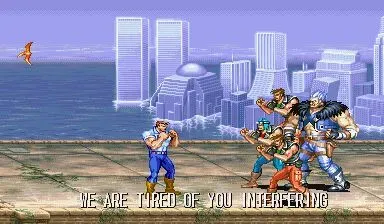
Cadillacs and Dinosaurs
[A footnote on the scrolling beat-em-up: brave retro-inclined fans have tried to revive this genre recently, particularly Core Design with "Fighting Force". But the frenetic arcade skills (where your money relied on your quick wits and you didn't have infinite credits) just doesn't translate to here and now. The game has been rejected as being 'too shallow', and that's both the failing and the saving grace of the entire genre of scrolling beat-em-ups. "Tekken 3" notes this down and dodges the brickbats neatly by including Tekken Force Mode, a scrolling "Final Fight" clone, as a bonus mode in the actual game!]
So the one-on-one beat-em-up languished in the shadows. But it was still being worked on - there was the classic 3-player "IK+" from Archer Maclean on the home machines. Capcom showed they were busy dabbling crazily with the original "Street Fighter" back in 1987, even including pressure-sensitive buttons. But it was a bit too crazy for most people, and the breakthrough would have to wait.
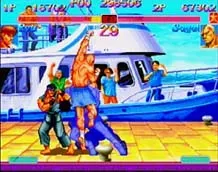
Street Fighter 2
The birth of the modern beat-em-up only really arrived with "Street Fighter 2", from Capcom in 1991. What did it do which really makes it an all-time classic? And can we still learn something from it?
Well, the first thing to say is that, 7 years later, Capcom are still releasing 2D one-on-one beat-em-ups that look essentially the same as "SFII" and share a lot of the same mythology and characters. This shows the massively enduring nature of the breakthrough they made with the title. The reasons why, perhaps, "SFII" is still the one classic beat-em-up are as follows:
1. Identifiable characters.
The kind of graphical breakthroughs Capcom had been making with titles like "Final Fight" made it possible to have a lissom Chinese girl, a Russian wrestler, an Indian fakir, and a sumo wrestler and make them all look individual and full of character. Sure, they were stereotypes, but they were clever, well-designed, stylish stereotypes. Besides which, where would the average "Die Hard" movie be without its share of stereotypical characters? Stereotypes in any artistic genre can be glorious as long as they're handled with some style.
2. A large number of choices of character.
Again, the arcade version of "Final Fight" had three characters to pick from - Capcom had begun to see the advantages of giving the player a large number of choices of main character. So, for "SFII", there were a far larger amount of choice, and you could pick a character. you especially identified with. There were many advantages to this - for a start, you were much more likely to replay the game to find out what each of the characters looked like and what they did. Allowing people to evolve their own favourites and styles was a massive breakthrough.
3. Giving each character its own special moves/gameplay characteristics.
A continuation of the last point - Capcom had began to evolve this idea by having each character in "Final Fight" do a special move by pressing the kick/punch buttons at once, and having different moves for each of the characters. In addition, Hagar was much slower than Cody but a lot stronger, for example. "SFII" took this so much further by having combinations of button presses and joystick moves do 'special' moves that particularly depleted the opponent's strength. This was a genius masterstroke, not to underplay it, heh, and giving each character different special moves to 'learn' upped the replay factor even higher.
4. More buttons.
Finally, this move was just the icing on the cake. Before, the player's options were pretty limited with just a kick and punch button to play with. But making "SFII" require 6 buttons per player, 3 punches and 3 kicks, added so much more strategy to the game. Hitting people harder knocked them out sooner but also left you more open to attack. Only by varying your punches and style could you defeat wily opponents.
So "Street Fighter 2" was the breakthrough the genre needed. One of the best points about it was that it was easily playable by novices, who were evenly matched (just hammer the buttons!). But the game was also massively long-lasting, because experts could trade Shoryukens and Spinning Bird Kicks all day long. Soon the phenomenon of "SFII" was so large that Jackie Chan (that man again!) paid tribute to it with a classic "SFII" dream sequence in his quite frankly deranged movie "City Hunter". As well as this, "Street Fighter: The Motion Picture" became a reality, only really notable for one of the last performances from the excellent Raul Julia. It's rumoured that Capcom funded the movie to the tune of millions of dollars and were badly burned when it was a big flop. Oops.
Perhaps only a giant like Capcom could have got away with needing an actual adaption to the JAMMA standard to get the extra buttons in place. But by getting 6 buttons in so many cabinets worldwide, and people turned on to the concept of one-on-one beat-em-ups again, they equipped the clone-makers to start the clones coming. "Eternal Champions" from Sega, "Primal Rage" from Midway and many others all followed a broadly similar mould. Only a few actually broke through to challenge the leaders of the nu skool, Capcom themselves.
The "Mortal Kombat" series from Bally/Midway were crass, rather simplistic, gory, but pushed many more buttons with American youth than the cartoony, more stylised "Street Fighter" series did. The fatality finishing moves were also an intelligent and important innovation - more moves to learn, but what a way to impress your friends!
SNK garnered a cult following in the rest of the world and truly mainstream acclaim in Japan with the still massive "King Of Fighters" series on the Neo-Geo system ("King Of Fighters '97" was top of the arcade top 10 in Japan recently, a fact not many people tend to spot.) These titles, and their siblings such as "Samurai Showdown" and "Fatal Fury", seem to work so well because their fans identify with the characters. They keep wanting to play new versions because of changes to special moves, new characters and so on. Basically, this is the Capcom approach, but with the characters being much more Japan-o-centric and having less worldwide appeal. And hats off to SNK for keeping it up.
Meanwhile, Capcom kept coining it in with a series of barely evolving, closely meshing fighters. The evolution of "Darkstalkers" in 1994 was an important advance for them, since it has showed they can still create a set of identifiable, stylish characters who really stand out. The "Vampire Hunter" anime based on the "Darkstalkers" titles is a testament to its crossover appeal. Even now, they're reluctant to venture out of their 2D niche, with titles such as "Marvel vs. Capcom" showing they're still very happy updating the "SF" legend. It works because they're master stylists and they had such a great concept to start with. But the "Street Fighter" series is no longer mainstream - it's moving slowly but inexorably towards cultdom, populated by geekoids who know every single special move in miniscule detail. But yet.. it's still great. My, the paradox that is Capcom, huh?
A footnote - there's still some very interesting 2D beat-em-ups coming out from parties apart from Capcom, and if you can stand the fact that, ohmigod, there's no polygons, it's well worth checking out titles such as "Waku Waku 7" by Sunsoft (on Neo-Geo and Saturn). They're a lot better than you think.
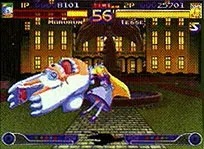
Waku Waku 7
3D, Schmee-Dee! & West vs. East
"Virtua Fighter" from Sega in 1993 was the start of a whole new ball-game. Just as many other genres were venturing into 3D in the early 1990s, it was a logical step for the beat-em-up to go that way as well. Of course, the major point is that, as with a lot of genres, the step into 3D really doesn't change anything - it's essentially the same game.
Just as "Tomb Raider" is allegedly "Prince of Persia" with the extra dimension, the only major differences with the "VF" series over Capcom's 2D competitors were flashier graphics, multiple camera angles, the novelty and approaching-realism excitement of having three dimensions. Of course, that was plenty enough to guarantee that 3D, the gimmick of the 90s, would overwhelm the genre. Nowadays, most people laugh and simply refuse to play 2D beat-em-ups.
For some reason, although they've been massive arcade hits, gamers and the press have never been quite so hot on the "Virtua Fighter" series compared to their major competitors.The argument as to why may hinge on this: perhaps Sega try to be too realistic in the fighting action. The most fun beat-em-ups often include outlandish moves that couldn't possibly happen in real life, where as the "VF" series was always rooted firmly in reality, moves-wise. "Virtua Fighter 3" was certainly a massive success, but much more on the amazing quality of the Model 3 visuals than the sparkling gameplay, perhaps. It's still excellent, professional, addictive, and has many fans. It's just not quite.. perfection.
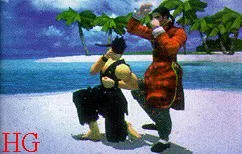
Virtua Fighter 3
And it was Namco, those clever old goats, who finally cracked the 3D beat-em-up genre wide open with the double whammy of "Tekken" and "Tekken 2". Great motion capture, a wicked diversity of characters, some great FMV, near-simultaneous arcade and console releases (or at least quite a bit close than their competitors!), and you have the second great milestone in beat-em-up history.
The competitors and those hoping to match up followed, as they always did. There were a great number in the Sega or Sega-affiliated camp, including "Fighting Vipers", "Dead Or Alive", even "Sonic The Fighters", which were all after a certain down-to-earth style of fighting, and all did extremely well. There's a number of more pale imitators of the "Tekken" style such as "Toh-Shin-Den" or a number of the Midway games such as "War Gods" or "Biofreaks", which tend to be reasonable to abysmal but a bit jaundiced. There's the interesting sidestep into the weapon-based beat-em-up which Namco made with "Soul Blade", graphically gorgeous and amazingly designed, but ultimately not quite controllable enough to be classic. There's even clones of that too (see "Dynasty Warriors" on the Playstation.)
In the past year or two, some of the young pretenders to the Sega/Namco throne have been getting it right - particularly Dream Factory/Square with the majestic "Tobal No.1" and "Tobal No.2", silky and Gouraud-shaded in high resolutions on the Playstation but perhaps a little quirky for audiences outside Japan. Additionally, Hudsonsoft have had a surprise hit with the wicked "Bloody Roar", also released as "Beastorizer" in the arcades. (Being one of the only Sega-gameplay-influenced titles on the Playstation, with ring and ring-out ideas borrowed from titles such as "Fighting Vipers", does "Bloody Roar" no harm at all, by the way.) Westerners have been getting it vaguely right, too, with Atari's "Mace:The Dark Age" at least being competent.
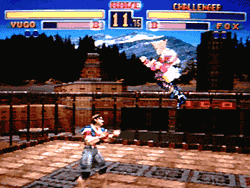
Beastorizer aka Bloody Roar
Even Capcom have been getting in on the 3D beat-em-up act, with their offshoot Arika working on "Street Fighter Ex", distinctly lukewarm in the arcades, but much improved on conversion to the Playstation. After initially disappointing starts with "Star Gladiators", Capcom's 3D work looks to be becoming a serious contender, with "Street Fighter Ex 2" soon to be released and looking formidable. Additionally, the recently released "Rival Schools United By Fate" (?!) is classy but perhaps too quirky for audiences outside Japan, who prefer their beat-em-ups a bit less "Beverly Hills 90210" and a bit more "Terminator 2".
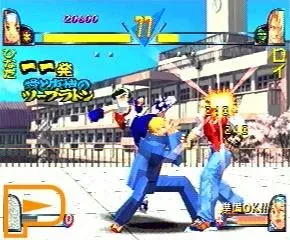
Rival Schools United by Fate
Recently, there's been an interesting move into true 3D beat-em-ups. There's the small interim step of sidestepping, which games such as "Tekken 2" and "Soul Blade" use well. But titles such as "Ehrgeiz" and "Bushido Blade" from Square actually allow the player to run around the arena in full 3D before attacking. The problem here has always been that it's very easy to keep running and never actually get in contact with each other. But it's definitely an interesting step, although it tends to lose the intimacy somewhat, with the characters all zoomed out and running away from each other. In many ways, the fixed, non-changable one-on-one game offers the closeness and the urgency that beat-em-ups need.
West vs. East
There is still a massive gulf still obviously in place between many Western and Eastern beat-em-ups,. however. For example, Westerners don't often understand that Lei fights in Drunken style in the "Tekken" series. Indeed, Western game-makers don't really understand the subtlties of the genre at all, why certain chains of moves work, and how the fluidity of play actually functions. This is perhaps why, for the past decade or so, there's never really been a great beat-em-up from anywhere outside Japan. Even the best Western attempts, such as "Masters of Teras Kasi" from Lucasarts, suffer from a number of major flaws that make them fiddly and somewhat shallow.
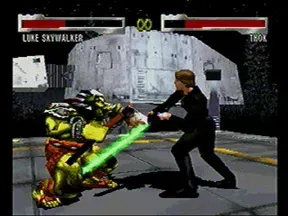
Masters of Teras Kasi
[Much as this author is uneasy to get medieval on any one publisher's ass, it's the distribution and marketing advantages of companies such as Midway that have put their beat-em-ups centre-stage in the States, rather than their inherent quality. If they released a title half as good as ignored arcade titles such as "Last Bronx" or "Beastorizer", they'd have gigantic hits on their hands.]
Wrap Up
So, for the benefit of those Western beat-em-up developers reading (in a tongue in cheek stylee!), and as a final part of the guide to kicking and punching, here's the ten things that the author thinks make a really good one-on-one beat-em-up.
1.A good set of characters.
The concept of style must not elude you - ie, make a set of characters people can identify with, rather than a bunch of semi-caricatured WWF goons (naming no names, heh).
2. Decent motion-capture.
Finding stylish dancers, fighters and choregraphers who understand the beauty of the human body in motion may sound a bit arty, but the best beat-em-ups use original body movements to create diversity and fun factor. Take Eddie from "Tekken 3", for example, a character who uses his breakdancing, freestyle moves to dance/kick his way to victory. Now that's cool.
3. Fluid chaining of motion captured moves.
A lot of Western beat-em-ups suffer awfully from having individually nice motion-captured moves that really don't bear much resemblance to what button-presses are being made. Actually, come to think of it, Eastern titles such as "Toh-Shin-Den" suffer from this as well. In any case, by far the best way to do things is to make the motion-captures short, easily chainable, and make the characters nimble and easy to control. "Tekken 2" does this to perfection, in that it actually feels like the character is totally responsive to your button-presses. Pressing a button and watching your character do a complicated attack for 5 minutes just doesn't hold water.
4. The best, most spectacular special moves.
If you've spent time doing a number of complicated button presses, you expect something spectacular for your pains. Perhaps Capcom have been overdoing it recently with 22-hit combos easily attainable in "Marvel vs. Capcom", but the satisfaction of pulling off a big move has to be linked to the visual effect that move has - ie, a big punch that looks normal but takes off half your opponent's energy is just no fun.
5. An intelligent control system
Most of the best beat-em-ups have a control system which starts simple, can be played simple, but gets increasingly complex. Thus, you can do kicks and punches easily, but multiple buttons taps and presses, all reasonably logical and easy to do, will give you more special moves. Most of the worst beat-em-ups either start simple and stay simple, thereby making the game degenerate into a slugfest (i hit him, he hits me, i hit him, he hits me.) Or, alternatively, the special moves areso illogical and complex that you need a hints book to guess them and a degree to remember them. Capcom games work so well on this level because people are used to the half-circle towards/away or tap down/up moves that generally produce special moves.
6 Great sound effects.
Often under-rated, if you can get the kicks, slaps, and yells of combat right, you're halfway there. "IK+" certainly sounds like it sampled Bruce Lee movies, and the called-out move samples in "Street Fighter II" have become absolute classics ("Spiiining Bird Kick!", "Yogaa Flame!"). Take your lead from that.
7. Good computer AI.. but not too good!
There's a subtle balance here. If you can beat almost all the opponents by simply inching forward and low-kicking (ahem, "Tekken 2", even you're in the wrong here!), then there's something seriously wrong. Equally, if the computer kicks your ass permanently by the time you get to the second round ("Dead or Alive" on Playstation, step forward!), you've got it wrong as well. Make your opponents a little unpredictable, never likely to fall for the same thing twice, and likely to make mistakes on occasion.
8. Properly balanced characters.
If one of the characters is so much stronger and faster than all the others, or has a ridiculously powerful special move that wipes out opponents just like that (this can be a problem with Devil in "Tekken 2"!), then it's obviously wrong. Don't make your characters generic, just balance speed against strength. The best example of this by far is in Capcom games such as "Marvel Super Heroes", where characters like Hulk and Juggernaut are still evenly matched against Wolverine or Spiderman, even though there's a massive difference in speed and size.
9. A decent winning pose.
If the character doesn't somersault, spin on the spot, grimace, wiggle her moneymaker, or something similar after you win a round, you know there's something wrong.
10. Some good secrets.
If you don't have a bunch of extra characters, special modes, and silly stuff to uncover in the process of beating everybody, then you're just not a proper game. Big props to "Masters of Teras Kasi" for being one of the first Western beat-em-ups to get this right. Darth vs. Luke? Mmmm.
Simon Carless is a game designer and team leader at a well-known independent UK games developer. he has previously contributed to a number of UK computer magazines, and was the co-editor of www.videogamedesign.com, scooping interviews with such greats as Chris Crawford and Peter Molyneux. His game credits include design on titles for Eidos and GT Interactive, and, as a true otaku, he owns almost every console known to man (although the FM Towns still eludes him!) In his spare time he attends philosophy lectures at Harvard, and runs the virtual record label Mono (http://www.scene.org/mono). He can be contacted at mailto:[email protected].
This article was first published in 1998. It has been lightly updated for formatting in 2023.
You May Also Like